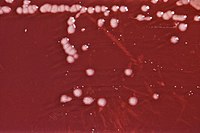
Photo from wikipedia
Degradation of polysaccharides forms an essential arc in the carbon cycle, provides a percentage of our daily caloric intake, and is a major driver in the renewable chemical industry. Microorganisms… Click to show full abstract
Degradation of polysaccharides forms an essential arc in the carbon cycle, provides a percentage of our daily caloric intake, and is a major driver in the renewable chemical industry. Microorganisms proficient at degrading insoluble polysaccharides possess large numbers of carbohydrate active enzymes (CAZymes), many of which have been categorized as functionally redundant. Here we present data that suggests that CAZymes that have overlapping enzymatic activities can have unique, non‐overlapping biological functions in the cell. Our comprehensive study to understand cellodextrin utilization in the soil saprophyte Cellvibrio japonicus found that only one of four predicted β‐glucosidases is required in a physiological context. Gene deletion analysis indicated that only the cel3B gene product is essential for efficient cellodextrin utilization in C. japonicus and is constitutively expressed at high levels. Interestingly, expression of individual β‐glucosidases in Escherichia coli K‐12 enabled this non‐cellulolytic bacterium to be fully capable of using cellobiose as a sole carbon source. Furthermore, enzyme kinetic studies indicated that the Cel3A enzyme is significantly more active than the Cel3B enzyme on the oligosaccharides but not disaccharides. Our approach for parsing related CAZymes to determine actual physiological roles in the cell can be applied to other polysaccharide‐degradation systems.
Journal Title: Molecular Microbiology
Year Published: 2017
Link to full text (if available)
Share on Social Media: Sign Up to like & get
recommendations!